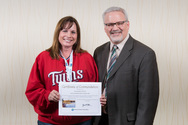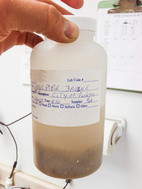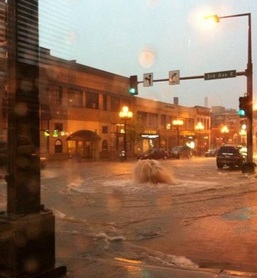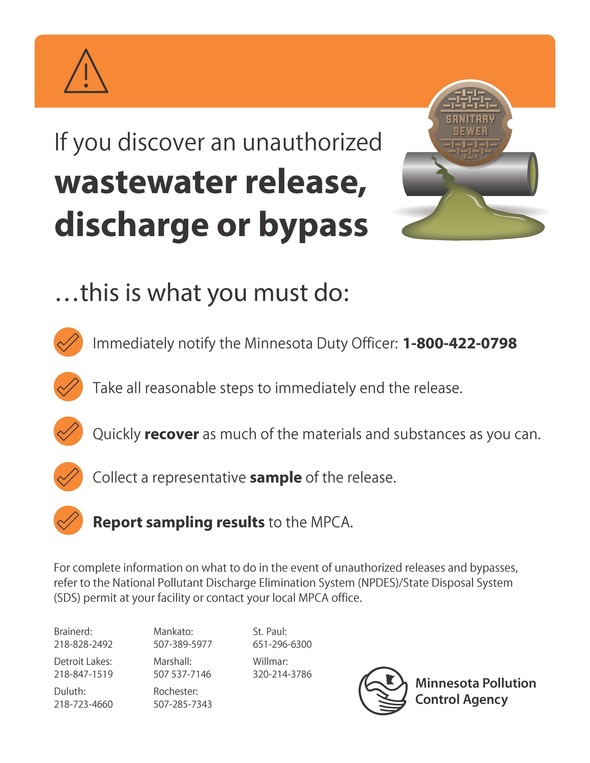|
May 2017
 The Minnesota Pollution Control Agency (MPCA) recently recognized 327
Minnesota wastewater treatment facilities for maintaining outstanding permit
compliance from September 2015 through September 2016.
MPCA Commissioner John Linc Stine presented the certificates and praised
award recipients for their persistent work and dedication to protecting water
quality: “Wastewater operators are at the front lines of keeping our water
clean. Every Minnesotan owes a debt to each of these
professionals.”
To be eligible for this recognition, facilities were required to submit all
monitoring reports to the MPCA correctly and on time, demonstrate consistent
compliance through monitoring or surveys, and employ staff certified by the
MPCA in wastewater operations.
The awards were presented at last month’s 80th annual Wastewater Operations
Conference in Brooklyn Park. A complete list of winners is available on the
agency's Wastewater
webpage. Pictures of awardees who picked up their awards in person are
available on the MPCA's Flickr page. Awards that weren’t accepted in
person will be mailed to the permittee. The agency is also sending this
information to all award recipients via email.
|

Minnesota has an increasing salty water problem that poses a threat to its freshwater fish and other aquatic life,
despite being more than 1,000 miles from the nearest ocean. Salt in the form of
chloride is finding its way to lakes and rivers from road salt runoff and water
softener discharge. It’s what some call a double-whammy, being a cold-weather
state that needs to treat roads for icy conditions and having naturally hard
groundwater that people need to soften.
Minnesota has worked for
several years to decrease road salt runoff, especially in urban areas. See the “Road salt and water quality” page on the MPCA website.
And now the state is starting
to focus on chloride in water softener discharge. Much of Minnesota has hard
water, prompting people to use water softeners. These softeners require salt to
operate. In most cities, these softeners discharge to the municipal wastewater
treatment plant. These plants are not designed to remove chloride in the
wastewater and it ends up discharging to the receiving water, usually a river
in Minnesota.
Chloride in water is a tough
problem to solve. It takes only a small amount – 1 teaspoon per 5 gallons of
water – to pollute water permanently. At high concentrations, chloride can harm
fish and plant life. But there’s no easy and affordable way to remove chloride
in wastewater. It would require reverse osmosis, the same process used to
produce water for laboratory use, which is technically difficult as well as
costly.
Based on studies,
reducing chloride in wastewater means reducing salt used in softeners. That
means cities either:
- Provide water already softened, thus eliminating the need for individual softeners
- Implement a program to put
high-efficiency softeners into use
The above options can also be
expensive and require large-scale change by residents and businesses. And in
most cases, the use of high-efficiency softeners, alone, will not result in
sufficient reductions to meet the water quality standard.
The MPCA has required several
WWTPs to monitor for chloride in their discharge since 2009. So far, more than
100 WWTPs have the potential to contribute levels of chloride higher than
allowed by the standard, which is 230 mg/L for chronic levels and 860 mg/L for
acute levels.
The common approach to reduce
pollutants in wastewater discharge is to assign a limit on pollutants in
facility permits, requiring WWTPs to invest in new processes and/or equipment.
In the case of chloride, however, the agency knew there was no simple solution.
MPCA Commissioner John Linc
Stine directed staff to form a work group of community representatives to:
- Study the chloride problem
- Make recommendations on how to implement the standard in municipal wastewater permits (the agency will
continue to work on chloride in industrial wastewater permits on a case-by-case
basis.)
The group consisted of 8
municipal representatives and 2 consultant engineers. Members met several times
from December 2016-April 2017. The group, represented by David Lane,
environmental manager for the Rochester Water Reclamation Plant, made its recommendations
to the MPCA Advisory Committee on April 18:
MPCA staff should use a
decision tree developed by the group to decide whether the agency will assign a
chloride limit in a WWTP’s permit with an associated schedule of compliance, or
consider a variance to allow time to determine a solution.
Factors in the decision tree
include:
- Is a reduction in chloride needed?
- Is the facility close to meeting the standard?
- Is construction needed to meet the chloride limit?
- Is the solution economically feasible?
For variances, the MPCA has developed a streamlined application tool that includes a spreadsheet calculator to determine affordability. The Chloride Work Group recommends:
- The agency allow municipalities to use the spreadsheet tool.
- Allow variances when the cost of treatment is too high.
- Waive the current variance application fee of $10,850 if municipalities use the streamlined application.
- Reissue variances when permits are reissued if there are no changes in the economics of the solution.
- Use best management practices to minimize a plant’s contribution to chloride concentrations. For example, some plants may be able to use different products for phosphorus removal that will also lead to lower chloride concentrations.
- Plants with variances must still have alternative limits in their permits to prevent “backsliding” or making chloride levels higher.
The same recommendations
would apply to other salty parameters such as bicarbonates and total dissolved
solids.
Work group members also said
the process was a good one, and the MPCA should consider similar work groups in
the future. They noted the collaboration among the agency, communities and
consultants in working on the chloride problem together. They also liked that
MPCA staff from both the permitting program and limits program were involved in
the process.
Commissioner Stine is taking
the recommendations into consideration and will communicate his decision in a
memo to staff. That decision will be communicated to permit holders through On
Point and through MPCA staff working with municipalities.
|
Several of the large “Omnibus”
bills under consideration in the Minnesota Legislature have provisions that
would change longstanding environmental protections in Minnesota. MPCA
leadership has testified against many of these provisions, arguing they are attempts
to fix so-called problems that do not actually exist. Some of the proposals introduce
uncertainty, red tape, and delay into required processes for permit holders in
Minnesota.
Some proposals would affect permits
for discharging wastewater, and actually slow down the agency’s permitting work:
- Banning a faster, more flexible companion process to rulemaking in which the agency provides guidance to regulated parties and avoids painstaking, formal rulemaking.
- Adding time to the permitting process.
- Placing
requirements on the permitting process that would actually bog it down with
legal challenges and the need to repeat processes.
Funding issues
The MPCA did not request increased funding from the Legislature in our FY 2018-2019 budget but instead proposed a flat budget. The legislative response so far has been to make cuts. For example, language in the transportation and energy bills puts at risk the $47 million due to Minnesota from Volkswagen as part of the company’s settlement for cheating emissions testing on its vehicles.
As far as the bonding bill, the MPCA continues to advocate for
critical funding toward water infrastructure. Gov. Mark Dayton has proposed
$167 million for the Public Facilities Authority:
- $25 million for the Clean Water and Drinking Water Revolving Fund
- $80 million for water infrastructure funding
- $62 million for Point Source Implementation Grants
The Minnesota Senate is proposing much less for the Public
Facility Authority at $133.5 million and the House even less at $105.7 million.
The final number will hopefully be hashed out before the
Legislature adjourns May 22.
More information
For more information about legislative proposals affecting wastewater permits, please see the MPCA website or contact Joel Peck, municipal liaison at 651-757-2202 or joel.peck@state.mn.us.
The MPCA is beginning the process of completing the
Wastewater Infrastructure Needs Survey (WINS) and Report as required by
Minnesota law (statue 155.03, Sub. 9). This survey assesses the current
condition and future needs of Minnesota’s publicly owned wastewater treatment
and conveyance infrastructure. The survey results help determine what Minnesota
communities require to address their wastewater needs, and what role the state
of Minnesota will play in providing resources and assistance.
You should expect to see new changes to WINS for 2017. In
the past, the agency conducted WINS as a paper, hard-copy survey through the
mail. Starting with the 2017 WINS, the survey will be electronic. You
should have received an email on May 2 that contains a link to
the WINS survey. Below are some quick facts about the survey:
- You may forward the survey email on to others to fill out portions of the survey
- You may save your work and exit the survey at any time; however, once survey portions are submitted, you may not go back into them
- Data from the 2015 WINS will populate the survey so you will only need to provide updates to that data or answer new questions for 2017
- A detailed instruction document will be sent out with the
survey
For more information, contact Cara Wright at the MPCA:
651-757-2891 or cara.wright@state.mn.us.

The communities are small, but their sewage treatment systems can be big
issues for them to manage. Many small communities depend on what’s called Large
Subsurface Sewage Treatment Systems (LSTS) for their wastewater. These systems
release treated wastewater into the soil, like individual home septic systems,
but include flow from about 30 or more homes. That’s why they’re
considered “large” – because they’re treating a few dozen homes instead of only
one.
LSTS provide a vital form of wastewater treatment in rural and less
populated areas because of lower installation costs and/or limited access to a
centralized community wastewater treatment system.
While small in size, these facilities can be difficult when it comes to
operation, management, and complying with discharge permit requirements,
especially when total nitrogen limits are necessary. Nitrogen limits
require "advanced" wastewater treatment to both nitrify and denitrify
wastewater to levels that protect groundwater for drinking water use. Two
recent MPCA studies show some of the difficulties for both new and existing
LSTS in relation to overall management and permit compliance.
The first study, “Small
Community Wastewater Treatment Program Start-Up Assistance and Management
Evaluation (December 2016)” focused on systems funded through the Public
Facilities Authority’s Small Community Wastewater Treatment Program. This
program provides loans and grants to local units of government to replace
failing and noncompliant individual sewage treatment systems with community
subsurface treatment systems.
As systems were implemented, the MPCA discovered that some owners struggled
to keep their new systems operating and maintained as intended. Permit
noncompliance was a common problem. So the MPCA began revisiting new
systems one year after start-up to:
- Provide help with treatment processes
- Confirm that systems were being operated and maintained as intended
- Assure that systems complied with permit requirements
The study evaluated 8 new systems and concluded that:
- These small wastewater treatment systems can be complex for communities to operate and expensive to manage
- Communities need to spend more time on operation and maintenance
- Communities and operators need to communicate better to manage problems
- Some indicated they should have been better informed on the amount of time and resources needed for operations and maintenance to budget better
The second study “Best
Practices Improvements: Nitrogen Pretreatment Performance of Land Based
Wastewater Treatment Systems (June 2016)” reviewed the performance of 10
existing LSTS with "advanced" pretreatment systems designed to meet
10 mg/L total nitrogen limits at the end-of-pipe, prior to discharge into the
soil. Results again showed the difficulties involved in staying in permit
compliance when it comes to nitrogen limits. Most facilities were not meeting
nitrogen limits throughout the year.
As part of this study, one-time operational and/or treatment process
improvements were made to some of these facilities, resulting in increased
nitrogen removal efficiencies at 6 of the 10 LSTS. The improvements
amounted to a total projected nitrogen reduction of more than 1,500 lbs/year.
The study demonstrated the importance of the following to keep LSTS in
compliance:
- Operation and maintenance
- Knowledgeable operators
- Sufficient resources
The study recommends that operators have a good understanding of nitrogen
removal and visit their treatment facilities at least once a week (two to four
hours) to complete operation and maintenance, along with reviewing compliance
status.
LSTS may be the only viable solution for some small communities and
residential developments, but those needing advanced wastewater treatment to
meet low nitrogen limits are not easily managed. These systems can and do
work, but require sufficient resources, ongoing operation and maintenance, and
a knowledgeable operator to keep them in permit compliance. Proper
operation and maintenance will also help protect the investment in wastewater
treatment infrastructure so that it can last for many more years.
If you have any questions about the studies or operations and maintenance of
these systems, contact the MPCA staff listed below:
|
 Spring is known as flood season for many wastewater treatment facilities. Make sure you are prepared by having spare pumps, generators, sand bags, and other equipment on hand, along with spare sample bottles in case of an unplanned release. Every wastewater permit issued by the MPCA includes requirements to maintain appropriate backup equipment and to collect representative samples of an unplanned release of wastewater.
Note on sample bottles
Many wastewater facilities receive sample bottles from contract laboratories which in turn are shipped back to the lab for analysis. Wastewater facilities should make sure they have enough spare sample bottles on hand, which may require contacting the lab to make arrangements. Please note that some sample bottles and/or preservatives may have expiration dates. So check bottle expiration dates at least twice per year and ask the lab how to store the bottles to maximize their use time.
Facilities should be prepared to analyze a release minimally for total suspended solids, fecal coliform and the other parameters listed on this MPCA wastewater release sampling report. Note that your facility’s specific permit may require parameters to be analyzed in addition to those listed on the form.
|
 Is it an overflow or a bypass? A refresher on terms
- Release: A release is any overflow or spill of wastewater or materials to the environment.
-
Sanitary sewer overflow (SSO): A release occurring from a sanitary sewer collection system (photo of pumping from collection system at right).
- Bypass: A bypass is the intentional diversion of a waste stream from any portion of your treatment facility. Examples of bypasses include diverting the flow of wastewater around a clarifier or de-chlorination system. Bypass wastewater must enter waters of the state from outfalls specially authorized by the facility’s permit and cannot, by law, cause an effluent limit exceedance.
If you must bypass/release
If a bypass or release is the only alternative, remember that you are obligated to:
-
Immediately contact the Minnesota Duty Officer at 800-422-0798 or 651-649-5451. If you need assistance or advice from the MPCA, you can inform the Minnesota Duty Officer or contact the MPCA directly. WWTF staff is often required to perform many tasks upon discovery of a release so it may be useful to designate a person to make a preliminary Duty Officer notification for the bypass/release. A final notification, with supplemental information, could then be made to the Duty Officer once all bypass/release details are obtained.
-
Discontinue the bypass/release as soon as possible. If a bypass/release is expected to last for more than a day or two, contact your MPCA representative to keep them informed of your status and to discuss sampling requirements.
-
Recover all substances and materials. In a flood situation this may not be possible, but a reasonable effort should be made to recover substances and materials to minimize human health and environmental impacts.
-
Collect representative sample(s) of the bypass/release. WWTFs should have sampling kits available to perform sampling requirements.
Resources on flooding preparation and response
|

|